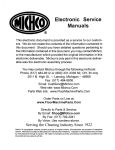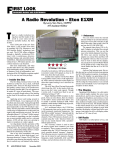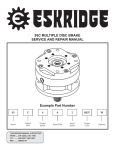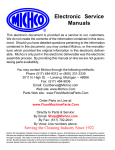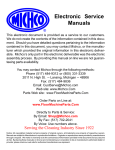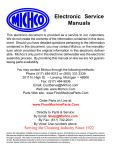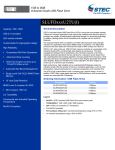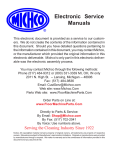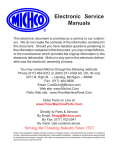Download Minuteman M220021H13 Specifications
Transcript
Electronic Service Manuals This electronic document is provided as a service to our customers. We do not create the contents of the information contained in this document. Should you have detailed questions pertaining to the information contained in this document, you may contact Michco, or the manufacturer which provided the original information in this electronic deliverable. Michco’s only part in this electronic deliverable was the electronic assembly process. By providing this manual on line we are not guaranteeing parts availability. You may contact Michco through the following methods: Phone (517) 484-9312 or (800) 331-3339 2011 N. High St. -- Lansing, Michigan -- 48906 Fax: (517) 484-9836 Email: [email protected] Web site: www.Michco.Com Parts Web site: www.FloorMachineParts.Com Order Parts on Line at: www.FloorMachineParts.Com Directly to Parts & Service: By Email: [email protected] By Fax: (517) 702-2041 By Voice: Use numbers above. Serving the Cleaning Industry Since 1922 Notice: All copyrighted material remains property of original owners, all trademarks are property of respective owners. Manuals are subject to Manufacturer’s reproduction limitations. Originals or reproductions were provided by manufacturers through a request. We make no warranty as to the correctness of information provided in this document and you assume all risk. By placing these manuals on line we are not declaring our corporation to be an manufacturer authorized dealer or provider, please check our web site for authorized manufacturers we represent. Mirage® Propane Burnisher OPERATION Model: M220021H13 SERVICE PARTS CARE TABLE OF CONTENTS Page 1 Unpacking Instructions, User Tips 2-4 General Warning Information 5-6 Engine Set-Up 7 Operation 8 - 10 General Maintenance Information 11 - 12 Trouble Shooting 13 - 18 Engine Specifications 19 Warranty Information Back Cover Warranty UNPACKING INFORMATION INSPECTION Carefully unpack and inspect your Burnisher for shipping damage. Each unit is tested and thoroughly inspected before shipment and any damage is the responsibility of the delivering carrier who should be notified immediately. ENGINES Engines are shipped with oil & coolant, if applicable. Refer to engine manual for correct weight and quantity. Briggs Vtwin 16 hp, Briggs 14 hp single cylinder, Kawasaki. Before starting engine check all levels. Do not overfill. PROPANE TANK The tank supplied with this equipment is a vertical vapor withdrawal 20 lb. tank. Do not overfill. Fill tank to 80% of rated capacity. Safety fill, Aluminum unpolished, polished, and steel. All propane tanks are equipped with this special warning sticker. Please read. WARNING: Vapor withdrawal tank weight fill only! Failure to weight fill tank will void warranty and cause damage to propane components! Tare weight is stamped on the tank. USER TIPS • Allow only qualified and trained personnel to operate a • Always check fuel system for leaks with soapy water. Minuteman Propane Buffer. (Hoses, regulators, connections) • Always maintain your Minuteman Propane Buffer, follow • Never smoke while operating or working on propane buffer. operating and maintenance instructions. • Do not attempt to change a pad while buffer engine is • Always check oil level before starting. running. • Always keep accurate records of maintenance and service • Keep hands, feet, hair, clothing, etc. away from buffing in a maintenance log book. pad, pulleys, and any other moving parts on equipment. • Never overfill a propane fuel tank. Be sure to follow safety • If you smell gas, do not touch any electric switch, instructions for venting overfilled tanks in safety section extinguish any open flame and contact your gas supplier, in this manual. and open windows. • Never leave machine unattended with engine running. • If there is any smell of propane fuel, check immediately for leaks and shut off tank at valve. • Never change or alter fuel system unless authorized by Minuteman International Inc. Service Department. • Do not store any other flammable liquids or vapors in the vicinity of propane storage area, machine storage area or • Always keep nuts and bolts tightened and hose any other appliance. connection snug. • Always clean recoil dust filters after 1 hour of use, and • Do not place flammable objects such as matches, fuel, etc., close to the engine while it is running. keep propane buffer clean. • Always store propane tank outside in an approved, • Never attempt to repair a propane fuel tank by yourself. Tanks can only be repaired by a Department of secured, and tamper proof enclosure to provide safety Transportation authorized facility. from vandalism and accidents. • Never use a non-UL listed fuel tank on your propane buffer. • For repairs or adjustments on your Propane Buffer use only an authorized Minuteman Service Center. • Always operate your propane buffer, with exhaust (muffler) ! CAUTION Visible escaping gas vapor is extremely pointed away from merchandise, furniture, etc. Heat from exhaust may cause damage. cold (ICE). Degrees (-44) avoid contact. • Never use a spray buff product over top of the engine. ! CAUTION Propane gas is heavier than air. The gas This could cause damage to engine if product got into will settle to the lowest possible area and build upwards. cooling system. ! CAUTION Build-up of propane vapor in any enclosed • For all engine repairs refer to the engine manual included area, can cause an explosion if ignited. Operate only in with this parts and instruction book. well-ventilated areas. 1 SAFETY PRECAUTIONS Before operating the engine, read the Operator’s Manual FUEL SYSTEM and become familiar with it and the equipment. Safe and • DO NOT fill fuel tanks while engine is running. efficient operation can be achieved only if the equipment is • DO NOT smoke or use an open flame in the vicinity of the engine or fuel tank. Internal combustion engine fuels properly operated and maintained. are highly flammable. The following symbols, found throughout this manual, alert • Fuel line must be LP approved, adequately secured, and you to potentially dangerous conditions to the operator, free from leaks. Piping at the engine should be approved service personnel, or the equipment. flexible line. Do not use copper piping for flexible lines as ! DANGER This symbol warns of immediate copper will harden and become brittle enough to break. hazards that will result in severe personal injury or • Be sure all fuel supplies have a positive shut-off valve. death. PROTECT AGAINST MOVING PARTS • Do not wear loose clothing in the vicinity of moving parts, ! WARNING This symbol refers to a hazard or unsafe such as PTO shafts, flywheels, blowers, couplings, fans belts, etc. practice that can result in severe personal injury or • Keep your hands away from moving parts. death. This symbol refers to a hazard or unsafe EXHAUST SYSTEM practice that can result in personal injury or product or • Exhaust products of any internal combustion engine are toxic and can cause injury, or death if inhaled. When property damage. operating the engine in a confined area, make sure the ventilation system is operating properly. Fuels, electrical equipment, batteries, exhaust gases and • DO NOT use exhaust gases to heat a compartment. moving parts present potential hazards that can result in • Make sure that your exhaust system is free of leaks. severe personal injury. Take care in following these Make sure that exhaust manifolds are secure and are recommended procedures. All local, state and federal codes not warped by bolts unevenly torqued. should be consulted and complied with. ! CAUTION EXHAUST GAS IS DEADLY! Exhaust gases contain carbon monoxide, a poisonous gas that can cause unconsciousness and death. It is an odorless and colorless gas formed during combustion of hydrocarbon fuels. Symptoms of carbon monoxide poisoning are: GENERAL • Provide appropriate fire extinguishers and install in convenient locations. Use an extinguisher rated ABC by NFPA. • Make sure that all fasteners on the engine are secure and accurately torqued. Keep guards in position over fans, driving belts, etc. • If it is necessary to make adjustments while the engine is running, use extreme caution when close to hot exhausts, moving parts, etc. • Used engine oils have been identified by some state or federal agencies as causing cancer or reproductive toxicity. When checking or changing engine oil, take care not to ingest, breathe the fumes, or contact used oil. • Do not work on this equipment when mentally or physically fatigued, or after consuming any alcohol or drug that makes the operation of equipment unsafe. • • • • Dizziness Headache Weakness and Sleepiness Throbbing in Temples • Vomiting • Muscular Twitching If you experience any of these symptoms, get out into fresh air immediately, shut down the unit and do not use it until it has been inspected. The best protection against carbon monoxide inhalation is proper installation and regular, frequent inspections of the complete exhaust system. If you notice a change in the sound or appearance of exhaust system, shut the unit down immediately and have it inspected and repaired at once by a competent mechanic. KEEP THE UNIT AND SURROUNDING AREA CLEAN • Make sure that oily rags are not left on or near the engine. • Remove all unnecessary grease and oil from the unit. Accumulated grease and oil can cause overheating and subsequent engine damage and present a potential fire hazard. 2 SAFETY INFORMATION For Your Safety! These safety precautions should be followed at all times. Failure to follow these safety precautions could result in injury to yourself and others. Explosive Fuel LPG is extremely flammable and is heavier than air and tends to settle in low areas where a spark or flame could ignite the gas. Do not start or operate this engine in a poorly ventilated area where leaking gas could accumulate and endanger the safety of persons in the area. Accidental Starts! Before servicing the engine or equipment, always disconnect the spark plug lead to prevent the engine from starting accidently. Ground the lead to prevent sparks that could cause fires. On engines equipped with a 12-volt battery and/or electric start, disconnect the battery cables from the battery. Always disconnect the negative (-) cable first. To insure personal safety, installation and repair of LPG fuel supply systems must be performed only by qualified LPG system technicians. Improperly installed and maintained LPG equipment could cause fuel supply system or other components to malfunction, causing gas leaks. Before disconnecting the negative (-) ground cable, make sure all switches are OFF. If ON, a spark will occur at the ground cable terminal which could cause an explosion if hydrogen gas or fuel vapors are present. Observe federal, state and local laws governing LPG fuel and systems. WARNING: Over-speed is Hazardous! Never tamper with the govenor components or settings to increase the maximum speed. Severe personal injury and damage to the engine or equipment can result if operated at speed above maximum ratings. ! ! CAUTION: High Voltage! Never touch electrical wires or components while the engine is running. They can be sources of electrical shock which could cause severe injury or burns. 3 SAFETY INFORMATION CONTINUED Lethal Exhaust Gases! Engine exhaust gases contain poisonous carbon monoxide. Carbon monoxide is odorless, colorless, and can cause death if inhaled. Avoid inhaling exhaust fumes, and never run the engine in a closed building or confined area. Rotating Parts! Keep hands, feet, hair, and clothing away from all moving parts to prevent injury. Never operate the engine with covers, shrouds, or guards removed. WARNING The 120V A.C. starter is equipped with a three-wire power cord and plug, and is designed to operate on 120V A.C. household current. The starter must be properly grounded at all times to avoid the possibility of injury or death from electrical shock. Always use a three-wire ground fault interrupted system. 715432 4 Hot Parts! The crankcase, cylinder head, exhaust system, and other components can get extremely hot from operation. To prevent severe burns, do not touch these areas while the engine is running - or immediately after it is turned off. Never operate the engine with heat shields or guards removed. ENGINE SET-UP PRE-START CHECKS Inspect the engine visually. Check for loose or missing parts Refer to Engine Owners Manual for the crankcase oil and any damage that may have occurred in shipment. capacity. Starting the engine without oil will Single-grade oil is preferable when temperatures are ! CAUTION result in severe engine damage. Add oil prior to starting consistently -over 30°F (0°C). Multigrade oils are best when the engine. wide temperature variations are anticipated. CRANKCASE OIL RECOMMENDATIONS ! WARNING Crankcase pressure can blow out hot Use premium quality motor oil with the API (American oil, that can cause severe personal injury. Do not check Petroleum Institute) designation SG on the container. Figure the oil level while the engine is running. 1 shows the recommended oil weight for the temperature range that the engine will be operated in. Make sure the ! CAUTION Excess oil can cause high oil engine oil weight is correct for the expected temperature range. consumption, high operating temperatures, and oil foaming. Do not overfill the crankcase. TABLE 1 FIGURE 1 5 PROPANE BURNISHER SET-UP CHECK OIL STARTING AND OPERATION PROCEDURE Refer to engine manual for the type of oil, and instructions for checking oil. It is important to note engine manufacturers differ in the way oil is checked. Add oil if needed. Refer to Page 10. CAUTION: NEVER ALLOW MACHINE TO RUN FOR MORE THAN 10 SECONDS IN ONE SPOT OR DAMAGE WILL OCCUR TO THE FLOOR! 1. Check oil and fuel levels. Make sure oil and propane tank is not overfilled. 2. Check and clean recoil dust filter and carburetor filter. Make sure air filter is free of dust and debris. Never run buffer for more than 1 hour without cleaning air filter. Change filters when necessary. PROPANE TANK INSTALLATION Buffer is supplied with 20 lb., 5 gallon capacity D.O.T. and U.L. 3. Check pad and pad assembly, to make sure pad is centered and clean, and look for any problems with pad listed tank. DO NOT OVERFILL. Overfilling will cause regulator driver. To do this turn machine over on its right side. to freeze. This could cause damage to your equipment. Hold tank in place by clamping the toggle assembly to the tank 4. Check belt tension, again turn machine over on its right side and squeeze belt together. Belt should depress band around the tank. Adjustments to the toggle assembly are between 1/4 and 1/2 inch. To change see maintenance made by screwing toggle in or out on the toggle clamp. Connect instructions. (Page 13) fuel hose to the tank valve by turning coupling to the right 5. Open propane service valve, turn counter-clockwise to (clockwise). Hand tighten only, making sure not to cross thread open. the coupling. 6. Tilt machine backward with pad off the floor, move bail to IDLE position. Never start machine with pad on the floor. REMOVING TANK To loosen turn coupling to the left (counter clockwise). Undo 7. With 115V starting system, plug in adapter to wall outlet and the starter box. Turn key to the on position and push the tank strap, remove tank and store in approved area. Do not button on start box. If machine fails to start allow store tank with machine in the janitor’s closet. approximately 30 seconds between tries, never engage starter more than 10 seconds at a time. INSTALLATION/CHANGING PAD a. Never start buffer with pad on the floor, this will 1. With engine off, turn the machine over on the operator’s cause the starter to burn out prematurely! RIGHT side (starter side) for the Briggs & Stratton models. b. Never use starting fluids or any other forms of This can be easily done by pushing down on the right side flammable substance to assist the engine in of the handle with some force while the machine is tilted starting! back. 8. Allow engine to warm up and run at normal operating 2. Remove the center cup retainer and carefully pull old pad speed before engaging pad with floor. Make sure pad is off the pad driver assembly. off the floor before engaging the clutch. Once machine is 3. Inspect the pad holder for cracks or damage. Replace if at normal operating speed and clutch is engaged, start necessary. NOTE: A DAMAGED PAD HOLDER ROTATING walking and slowly lower the machine to the floor and AT HIGH SPEEDS MAY BE AN EXTREME HAZARD IF IT begin burnishing the floor. SHOULD COME APART. 9. Machines with mechanical clutches: NOTE: Never engage 4. Pull center from new pad, enter pad on pad holder and clutch with pad on floor. Once machine has reached secure with center cup retainer. normal operating speed clutch is engaged automatically 5. Press pad on to the pad driver assembly making sure at 2400 engine RPM and start burnishing. Start burnishing pad fits inside the lip of the pad driver assembly, to prevent when pad has reached top speed. pad from elongating, attach center cup retainer. 10. Always burnish on the right hand, so exhaust fumes are 6. Return machine to the upright position. blown to the inside of the aisle. Be careful exhaust fumes and muffler are extremely hot and will damage TRANSPORTATION merchandise. NOTE: Do not expose skin to muffler or When transporting a propane powered floor machine with the manifold - extreme heat, will burn. fuel cylinder attached, the cylinder should be securely fastened 11. For normal stops of the machine, turn propane service with service valve closed and coupling not attached. The valve clockwise, to starve the engine of its fuel. Do not machine should be secured to the vehicle to avoid movement. stop machine by using the bail or ignition key, you can trap Tanks separate from the machine should be secured to avoid fuel in the lines, which can cause a backfire and cause movement. NEVER STORE MACHINES WITH TANKS IN AN damage to the engine. NOTE: In case of emergency ENCLOSED VAN OR TRAILER. ALWAYS CHECK TANKS FOR always turn ignition key off. NOTE: Machines without OVERFILL BEFORE TRANSPORTATION. clutch, the pad starts to rotate immediately when engine starts. Pad stops rotating when engine is off! No clutch! HANDLE ADJUSTMENT Adjust handle by loosening nuts and bolts on each side of handle. Push handle handle in or pull out to desired position and reinstall nuts. 6 OPERATION INFORMATION ENGINE BREAK-IN Engine break-in as a result of proper care during the first hours of operation of a new or rebuilt engine results in the ideal fitting of all internal moving metal parts, which is essential for top engine performance. For controlled engine break-in. 1. Operate the equipment as it is intended to be operated. However, for the first 3 hours, if possible, operate the equipment at about half the available engine power, occasionally operating at full engine power for brief periods. Also, if possible, avoid prolonged low-speed, low-power operation during engine break-in. 2. Proper engine oil is especially critical during break-in because of the higher engine temperatures that can be expected. See RECOMMENDED ENGINE OIL. Change the oil if it is not appropriate for the ambient temperatures during the break-in periods. See Table 1, Figure 1 Page 6. 3. Check the oil level twice a day or after every 4 hours of operation during the first 24 hours of operation. 4. Change the oil and oil filter after the first 5 hours of operation. After engine has reached operating temperature while pad is still off the floor. Before lowering burnishing head, adjust throttle to operating speed. After slowly lowering machine to floor, place hands lightly on the handle and allow the machine to create the floor pressure. Bearing down and pushing hard will lead to premature belt problems and operator fatigue. For smoother turns and greater maneuverability, buff aisles from the right side first. CAUTION: DO NOT RUN MACHINE FOR MORE THAN 15 SECONDS IN ONE SPOT OR BURNING WILL OCCUR. IDLING AND STOPPING THE MACHINE If for any reason the machine needs to be idled for short periods, simply tilt machine back on its rear caster and release throttle bail into Idle Position. Machine will now idle safely. (CAUTION: DO NOT IDLE BUFFER ON REAR CASTER FOR MORE THAN TWO MINUTES. This will raise the emissions level.) To stop machine tilt back on rear caster, turn valve on propane tank off, and allow fuel in the lines to be used up. FOR EMERGENCY SHUT OFF ONLY: turn off ignition OPERATION IN DUSTY CONDITIONS switch. Electric start models: use emergency stop switch 1. Keep the engine cooling fins and flywheel air inlet screen on right side of control panel. and precleaner (filter) clean. 2. Perform air cleaner maintenance more often than STORAGE normal - as required. Only authorized and properly trained personnel should have 3. Change the engine oil more often than normal. See access to propane tanks and machine. Table 2, Page 10. Making sure tank valve is closed, remove tank from buffer. Local Fire Codes may require storing tank in separate OPERATION IN HOT WEATHER location. We recommend this, as well as following Pay particular attention to the following items when Local Fire Codes. operating the engine in temperatures above 100°F (38°C): Store machine and tank away from objects that may fall 1. Keep the engine cooling fins and flywheel air inlet screen and damage them. and precleaner (filter) clean: See to it that nothing Never store tank or buffer near open flame or heat producing obstructs air flow to and from the engine. devices. Make sure machine is cleaned properly prior to storage. 2. Check the oil level more frequently. 3. Change the oil more often than normal. See Table 2, To prevent damage pad holder, the pad SHOULD remain on machine during storage. Page 10. 4. Make sure the engine oil viscosity is appropriate for the ambient temperature and change the oil if EMERGENCY STOP Turn ignition key to OFF position. necessary. See Table 1, Figure 1 page 6. Units with emission control device and clutch. Release bail on handle to activate kill switch. OPERATION IN COLD WEATHER Pay particular attention to the following items when operating the engine in temperatures below freezing. Make sure the engine oil viscosity is appropriate for the ambient temperatures and change the oil if necessary. See Table 1. If the temperature drops before you have the chance to change the oil, warm up the engine by moving the equipment into a heated space before attempting to start the engine or change oil. 7 MAINTENANCE SCHEDULE PERIODIC MAINTENANCE SCHEDULE Following the maintenance schedule and using the engine properly will result in longer engine life, better performance and safer operation. Perform each maintenance procedure after the number of operating hours indicated. These service intervals are recommended for normal operating conditions. For operation in hot or dusty conditions, service the engine more frequently. Neglecting routine maintenance can result in premature engine failure. For any abnormalities in operation, unusual noises from the engine or accessories, loss of power, overheating, etc., contact your nearest Engine Service Center. Refer to the following Maintenance Procedures section for routine maintenance procedures. TABLE 2. PERIODIC MAINTENANCE SCHEDULE AFTER EACH CYCLE OF INDICATED HOURS SERVICE THESE ITEMS 1 8 Recoil Dust Filter X 100 200 X X2 Service Air Cleaner Element and Element Wrapper Change Crankcase Oil X3 Replace Oil Filter (Onan, Kawaski Models) X3 X X X2 X Clean Cooling Fins Clean Spark Arrester X4 Check Valve Clearance 1 2 3 4 50 X1 Inspect Engine Generally Check Oil Level 25 X Replace Air Cleaner Element X2 Check or Replace Spark Plug X - Check for fuel leaks. With engine running, visually and audibly check exhaust system for leaks. - Perform more often when running under severe operating conditions. - Required for initial break-in only. - Required for initial 100 hours, 200 hour interval thereafter. For detailed maintenance, refer to the Engine Service Manual. ! WARNING Breathing exhaust gases can result in severe personal injury or death. Do not use air cleaner, exhaust elbow, or connecting parts as a supporting step. Damage to these and connecting parts can cause an exhaust leak. 8 MAINTENANCE PROCEDURES 4. Check the engine oil level. The equipment must be Accidental starting of the engine can parked on a level surface and the engine stopped. To result in severe personal injury or death. Disconnect get an accurate reading, wait a minute or so to allow the 110 VAC power cord from the starter switch junction the oil to settle in the crankcase if the engine has been box or disconnect the negative (-) battery cable on 12 running. VDC starter models. Also disconnect the spark plug wire while servicing the engine, controls, or associated ENGINE MAINTENANCE 1. Cooling Fin Maintenance: Remove the blower housing equipment. and other cooling shrouds. Clean the cooling fins as HOURLY CHECK necessary using compressed air or pressure washer. Due to the large amount of dust that can be encountered in Reinstall all housings and shrouds. floor care applications, the recoil dust filter should be 2. Head Bolt Maintenance: Refer to Engine Manufacturer’s checked after each hour of operation. Remove and clean Service manual. the filter. BELT MAINTENANCE DAILY CHECKS NOTE: To inspect the belt it is necessary to turn the machine The operator should make a complete visual and audible over. The machine should be turned to the operator’s right inspection of the engine daily. Check the following before side for all Briggs & Stratton models. If the belt is badly starting the engine for the first time each day. cracked or worn, it should be replaced. To check for the 1. Check all fuel lines and fitting for possible leakage. proper tightness, squeeze the belt together. The belt should 2. Check crankcase oil level with the engine off. If engine depress between 1/4 and 1/2 inch. To change belt follow has been run, allow a minimum of 10 minutes for the these instructions: oil to drain down before checking. Check oil level with • Turn burnisher over on the right side. machine in operating position. Do not operate engine • Remove the pad holder by holdng the end of the with the oil level below the ADD mark or above the FULL shaft on the top of the machine with a 3/4 inch mark. wrench and turn the pad holder counter-clockwise. 3. Inspect exhaust system for possible leakage and • Using the 3/4 inch wrench to turn the end of the cracks. Locate leaks in muffler and piping while the spindle shaft on the top of the machine while engine is operating. Repair leaks immediately. removing the old belt from the spindle pulley. 4. Inspect air cleaner system for leaks. Make certain all • Check engine pulley for correct alignment with the clamps and fittings are tight and free of potential leaks. spindle pulley. Check hardware attaching pulleys 5. Check the engine cooling system to make sure the for correct tightness. cooling fins and ducting area are clean. Remove dust, • Install the new belt onto the engine pulley. dirt or oil from the cooling surfaces. • Reinstall the new belt onto the spindle pulley using DAILY (8 HOUR) MAINTENANCE the 3/4 inch wrench to turn the spindle clockwise. The operator should check the following before the first Make sure the belt is correctly placed on the idler start of the day and after every eight hours of operation: pulley. 1. Inspect fuel lines and fittings for leaks. Repair leaks • Check belt for correct operation. immediately. • Check all hardware for correct tightness. 2. Look and listen for exhaust system leaks while the FUEL SYSTEM engine is running. Look for cracks and severe rusting The fuel system works from vacuum created by the engine in the muffler and tailpipe. Have all leaks repaired before running. Turning the cylinder service valve on pressurizes continuing to operate the equipment. the system for flow to the carburetor once the engine starts ! CAUTION Hot exhaust parts can cause severe to crank. burns. Allow the engine time to cool before 1. Engine Dust Filter: FAILURE TO MAINTAIN A CLEAN servicing the exhaust system. ENGINE FILTER MAY CAUSE THE EXHAUST 3. Check the engine for dirt and debris and clean the EMISSIONS TO ELEVATE TO DANGEROUS LEVELS. flywheel air inlet screen and cylinder cooling fins as ALSO, IT WILL CAUSE THE ENGINE TO OVERHEAT, necessary. On floorcare equipment engines, remove AND EVENTUALLY DAMAGE THE ENGINE. The the cooling air precleaner element every 4 to 8 hours of engine dust filter should be cleaned each hour and operation and wash it in warm water and mild detergent. after each use by shaking out the dust and then rinsing Rinse it thoroughly and let it dry before reusing it. Do with soapy water. Allow filter to air dry, do not wring not oil the element. out water, this could damage the filter, (squeeze out). 2. Fuel System Adjustment:The carburetor and regulator ! CAUTION A clogged flywheel air inlet precleaner have been pre-set at the factory and do not require any or screen or dirty cooling fins can cause overheating modification. Only authorized, trained personnel should and engine damage. Keep the cooling fins and air inlet work on the fuel system of a propane buffer. screen clean. ! WARNING 9 MAINTENANCE PROCEDURES NOTE: N.F.P.A. rule 58 8-1.4 states, “In the interest of safety, each person engaged in installing, repairing, filling, or otherwise servicing an LP-Gas engine fuel system shall be properly trained in the necessary procedures”. 3. Hose and Fuel Connections: Inspection: Check for gas leaks by using a soapy water solution around all connections with service valve turned on so the fuel system is pressurized. Inspect all hoses for abrasions and other signs of wear. Replace all damaged and worn hoses. Fixing Leaking Joints: Uncouple bad joint, clean joint and apply pipe sealing compound (use a Loctite Pipe Sealant with Teflon or equivalent) to clean joint. Re-couple the joint, tighten plus 1/2 turn. Recheck for leaks. 4. Carburetor Air Filter: NOTE: Failure to service and clean carburetor air cleaner may produce excessive carbon monoxide emissions. • Remove cover from the air cleaner. • Remove foam pre-cleaner and use the same procedure for cleaning the foam pre-cleaner. • Rinse in mild detergent and squeeze out excess water, do not wring out. • Clean filter seal, making sure no dust is allowed in the carburetor inlet. • Inspect paper element. Replace if dirty, bent or damaged. • Install the clean paper element, pre-cleaner, and attached air cleaner cover. If the oil level is low, add API Class SG or SH oil (also SG/ CD, SG/CE, SH/CD or SH/CE) having an SAE viscosity grade appropriate for the expected temperatures, as indicated by Table 1. DO NOT FILL TO A LEVEL ABOVE THE FULL MARK ON THE DIPSTICK. Drain the excess oil if too much has been added. ! CAUTION Too much oil can cause high oil consumption, high operating temperatures and oil foaming. Too little oil can cause severe engine damage. Keep the oil level between the Full and Add marks on the dipstick. Reinstall the dipstick and cap after checking or adding oil, turning it clockwise until it is secure. OIL CHANGE ! WARNING Hot crankcase oil can cause burns if it contacts the skin. Wear protective clothing and keep fingers and hands clear when draining oil. Used oil is harmful to the environment. Pour used oil into a sealed container and deliver it to the nearest recycling center or automotive service station. CHANGING THE OIL 1. Run engine for 5 minutes to warm oil, then stop engine by closing the service valve on the tank. Turn the key to the off position. 2. Locate the oil drain located the right side of the engine at its base. Remove the cap on the oil drain tube by turning counter clockwise with a wrench. 3. Allow oil to drain completely into the receptacle. 4. Replace the cap by turning clockwise. 5. Remove oil fill cap. Always refer to the Engine Manual for recommended oil and amount. 6. Check oil level with dip stick in oil fill cap. Add additional oil if necessary. NOTE: TO CHECK OIL ON THE BRIGGS & STRATTON MODELS, SCREW THE CAP IN AND OUT AGAIN. ALWAYS MAKE SURE THE MACHINE IS SITTING LEVEL WHEN CHECKING OIL. 7. Replace fill cap. Hand tighten only. 10 OIL FILL CAP AND DIPSTICK TROUBLESHOOTING Table 3 provides basic troubleshooting guidance. If you fail to ! WARNING Hot engine parts can cause severe burns. resolve the problem after taking the corrective actions Always allow the engine time to cool before performing any suggested, contact the equipment or engine dealer. maintenance or service. ! WARNING Many troubleshooting procedures present hazards that can result in severe personal injury or death. Only qualified service personnel with knowledge of fuels, electricity, and machinery hazards should perform service procedures. Review Safety Precautions. TABLE 3. TROUBLESHOOTING Problem Corrective Action 1. The engine fails to crank a. Not pluged into outlet. 2. The engine cranks slowly. a. Change engine oil having the proper viscosity for ambient temperature. See table 1. b. Check oil level for overfilling. c. Check starter electrical connections. 3. The engine cranks but fails to start. a. Check the fuel tank or LPG container and fill as necessary. b. Check, and if necessary, reconnect the fuel line to the vapor-withdrawal fitting on the LPG container. c. Open any closed fuel shut-off valve (check keg in on position). d. Check engine oil level and add oil as necessary. e. Service the air cleaner. f. Clean the air precleaner (floorcare engines). g. Replace the spark plugs. 4. The engine runs and then stops. a. Check the fuel tank or LPG container and fill as necessary. On cold days the LPG container may have to be kept at least half full to provide the rate of vaporization necessary to keep up with the engine fuel demand. b. Check, and if necessary, reconnect the fuel line to the vapor-withdrawal fitting on the LPG container. c. Check the engine oil level and add oil as necessary. Drain excess oil if the level is above the dipstick FULL mark. 5. The engine exhausts black smoke. a. Service the air cleaner. 6. The engine misfires. a. Replace the spark plugs. 11 TROUBLE SHOOTING ENGINE WILL NOT START EXCESS VIBRATION CAUSES: No fuel, blown head gasket, bad ignition coil, dirty air cleaner, wires broken or disonnected, engine overload, insufficient vacuum, bag spark plug, fuel system out of adjustment. CAUSE: Engine overload, loose bolts on engine or deck of unit, low fuel level, dirty air filters, faulty spark plug, pad not centered. SOLUTION: Refer to engine manual for servicing and instruction. SOLUTION: Refer to engine manual for servicing and instruction. MACHINE PULLS TO ONE SIDE HARD TO START CAUSE: Bent wheel bracket, wheel is wearing too much on one side. CAUSES: Kinked fuel line, dirty air filter, bad spark plug, blown head gasket, low oil, engine overload, carburetor needs SOLUTION: adjustment, regulator needs adjustment, insufficient Check for bent bracket or worn wheel. vacuum, improper timing, coil or valves need adjusting. SOLUTION: Refer to engine manual for servicing and MACHINE “BOGS DOWN” WHEN IN USE instruction. CAUSE: Too much pressure or operator is bearing down too hard. ENGINE LACKS POWER Dirty air filters. CAUSES: Head gasket leaks, governor improperly adjusted, check air filter, insufficient vacuum, bad spark plug, no compression worn rings, improper valve clearance, kinked fuel line, improper oil level. SOLUTION: Follow proper operating instructions, let machine operate on its own weight, do not apply upward pressure to handle of machine. ENGINE STOPS RUNNING SOLUTION: Refer to engine manual for servicing and instruction. CAUSE: Out of fuel, faulty spark plug, low oil, dirty air filters, high exhaust emissions. SMELL OF BURNED RUBBER CAUSE: Belt out of adjustment. SOLUTION: Refer to Maintenance Procedures. SOLUTIONS: Refer to engine manual for servicing and instruction. HIGH FUEL CONSUMPTION CAUSE: Dirty air filters, dirty air cleaners. SOLUTION: Keep engine and air filters clean. 12 ENGINE 13HP HONDA 13 PARTS LIST for 13HP HONDA Item 1 2 3 4 5 6 7 8 9 10 11 12 13 14 15 16 17 18 19 20 21 22 23 24 25 26 27 28 29 30 31 32 33 34 35 36 37 38 39 40 41 42 43 44 45 46 47 48 49 50 51 52 53 54 55 56 57 58 59 60 61 62 63 64 65 66 Part No. Qty. 360108 1 712638 2 711503 4 515-10-24 2 220131 1 715343 1 220118 1 220393 1 711505 4 220056 2 711373 8 220385 1 711515 4 711439 4 711506 6 713031 2 220482 1 220021PTD 1 711544 4 711203 4 713043 4 831306 1 220221 1 350280 1 220246 1 220483 1 220237 1 220245 1 342430 1 450076 2 220269 1 220192 1 220070-1 1 220065 1 62-252-A 1 715501 1 715245 1 740539 1 715192 1 715242 1 741056-1 2 741056 1 829052 2 711721 2 220112 1 55-161-A 2 220343 1 711374 2 220338 1 220339 1 711207 4 713036 2 711380 4 711213 4 712538 2 255045 1 220328-1 1 711301 2 711551 2 220270 1 711225 4 711388 2 711504 2 713042 4 711439 4 715432 1 Description Handle Sleeve Nut-Hex 10-24 Nyloc WSR-Flat #10 SCR-RD HD 10-24 x 1 1/2 Buckle TB2-61 Decal, Propane Warning Propane Tank Steel Battery Cover Weldment WSR-Flat 1/4 Felt 2 x 10 Nut-Nyloc 1/4-20 Engine 13 HP Prop Honda WSR-Flat .406 x .812 x .06 Nut-Wizz 3/8-16 WSR-Flat 5/16 BLT-HH 5/16-18 x 2.00 Starter Assy, 115V Tecumseh Casting WSR-Helical 1/4 BLT-HH 1/4-20 x .62 BLT-HH 3/8-16 x 1 1/4 #5 90o Elbow Street 1/4-1/4 Electric Lockoff Assy Hose Barb 1/8 x 1/8 NPT Elbow-90 1/8mpt x 1/8fpt Regulator Beam T60-E Regulator Bracket Elbow-45 3/8mpt x 3/8fpt Hose Barb Crimp Clamp Fuel Hose - 3/8 ID x 30” Tank Frame Weldment High Pressure Hose 45° Male Elbow 1/4 x 3/8 Connector - Female Decal - Made in USA Decal - Ignition Switch Hour Meter Decal - Dashboard Decal - Propane Warning Key-Ignition, Replacement Keyswitch w/Ground Nylon Bushing Retaining Ring Torsion Spring WSR-Special Handle Nut-Nyloc 5/16 Handle Bracket LH Handle Bracket RH BLT-HH 1/4-20 x 1.00 BLT-HH 5/16-24 x 1.25 BZ Nut-Nyloc 3/8-16 BLT-HH 1/4-20 x 1.62 SCR-MC 10-24 x 1.75 SS Spacer, .19 x .37 x .47 Cable, Lined Nut-Hex 6-32 WSR-Internal LOC #6 Bail, Throttle LH Cable BLT-HH MM6 x 1.0 x 20mm Nut-Hex 6mm WSR-Flat 1/4 SS BLT-HH 3/8-16 x 1.00 #5 Nut-Flanged Wizz 3/8-16 Decal, GFCI Warning 14 ENGINE 13HP HONDA 15 PARTS LIST for 13HP HONDA Item Part No. Qty. 1 2 3 4 5 6 7 8 9 10 11 12 13 14 15 16 17 18 19 20 21 22 23 24 25 26 27 28 29 30 31 32 33 34 35 36 37 38 39 40 41 42 43 44 45 46 711545 6 711354 1 711546 1 430029 1 711506 6 713165 4 220330 2 220049 2 220340 2 713049 2 220198 1 72-179-A 1 833621 1 220197 1 82-138-B-3 1 350242 1 60-716-24 1 712112 1 220040 1 77-81-A 1 220041 1 364-816 1 220010 1 220097 1 220019 6 760401 1 760402 1 220005 1 220020 12 220018 1 220022 1 220045 1 220044 1 711719 2 220003 1 220002 1 762093 2 220023MCH 1 220016 1 220119 1 828894 12 715385 1 220021PTD 1 55-161-A 2 711374 12 711380 2 Description WSR-Helical 5/16 Nut-Acorn 3/8-16 WSR-Helical 3/8 Caster WSR-Flat 5/16 SCR-FH SC 5/16-18 x 1.00 Wheel Bracket Weldment Bushing .381 x .5 x 1.75 Wheel 6” BLT-HH 3/8-16 x 2.75 Spacer Spacer Key 1/4 x 1/4 x 1.00 Pully-4.6 OD Special Washer Belleville Washer 7/16 BLT-HH 7/16-20 x 1.5 BLT-HH 1/2-13 x 2.75 Rotary Tensioner Spacer Belt Idler w/Bushing Nut-Nyloc 1/2-13 Belt Tensioner Assy. V Belt BX44T (M220021K17,K17C) Gimbal Spacer Disc Center Cup Center Cup Retainer Metal Spinning (M220021K17,K17C) BLT-Special Elevator Gimbal Disc Adapter Split Tapered Bushing Pulley Retaining Ring, Ext. 1.00 Key, Woodruff 5/16 x 1 Shaft, Pad Driver Bearing Bearing Housing Skirt (M220021K17,K17C) Skirt Retainer (M220021K17,K17C) Pop Rivet Decal - Minuteman Casting WSR-Special Nut-Nyloc 5/16 Nut-Nyloc 3/8-16 16 WIRING DIAGRAM 13HP HONDA 17 MODEL 50 DRY-GAS REGULATOR, CROSS SECTION, PARTS LIST Item Part No. ** ** ** 1 2 3 4 5 6 7 8 9 10 11 12 13 14 15 16 17 18 19 20 21 22 23 24 25 26 27 NS 60-RBK 60-RCK 60-RK P3-13 50-1 2G-150 60-10A 60-7 60-8 60-31 60-32A 60-4 60-2B 103205-F 60-5 60-3 103210-FS 60-29A 60-15A 60-14 60-22A 60-23 103206-P 60-16 60-17 60-18 60-19B 60-28 400-21 PS-20A 103204-P Qty. 1 1 1 1 1 1 1 1 1 1 2 1 1 10 1 1 1 1 1 4 1 1 1 1 1 1 1 2 Description Kit, Rebuilding Kit, Complete Kit, Repair Plug, 1/8” Pipe, Hex 1 1 Casting, Reg. Body Gasket with 60-10A Diaphragm, Primary 1 1 Cover, Primary Spring, Primary 1 1 Retainer Spring Cap, Retainer Spring, Primary 1 1 Lever, Primary 1 1 Screw, Machine 2 2 Bridge Primary Pin, Pivot 1 1 Screw with Lockwasher10 10 Orifice, Primary 1 Diaphragm, Vac Lock 1 1 Spring, Vac Lock 1 Diaphragm, Secondary 1 1 Cover, Secondary Screw, Machine 4 Ring, Vac Lock Spring, Machine 1 Pin, Pivot 1 Lever, Secondary 1 1 Orifice, Secondary 1 Spring, Idle 1 Screw, Idle 1 Screw, Machine 2 1 1 4 1 1 1 4 1 1 1 1 1 2 Order by Part No. NOT by Reference No 18 REGULATOR OPERATION LP-gas vapor enters at point (A), then passes into primary area (B) at point (28), where pressure is reduced from up to 250 p.s.i. at the tank to 4 p.s.i. in area (B). Fuel pressure against diaphragm (4) overcomes spring (6) and as movement increases, spring (9) will close lever (10). The primary diaphragm breather (not shown in drawing), is vented to secondary chamber so that rupture of this diaphragm would direct fuel into the carburetor. Fuel now moves through passage (E), past secondary valve (29) into secondary area (C). As negative pressure (vacuum) is created at carburetor venturi and is transmitted through dry-gas hose to chamber (C) atmospheric pressure, exerted through vent hole (G), forces down secondary diaphragm (18), secondary lever (24) and spring (22). Fuel will flow in proportion to air velocity through carburetor venturi, insuring an ideal mixture at all engine speeds. Whenever engine is operating, vacuum diaphragm (16) is down against floor (H) and spring (17) is collapsed. The idle and starting adjustment is made with tapered screw (27) which regulates the whisker wire system (not shown), opening up secondary orifice slightly (but only when vacuum diaphragm is drawn down). Very little vacuum is needed to start this vacuum diaphragm travel; 0.2” Mercury to start and 0.5” Mercury for full travel. The instant engine stops rotating, loss of vacuum in section (D) releases diaphragm (16), causing bumper (K) to push against secondary lever (24), overcoming action of whisker wire and insuring 100% lockoff. This patented Beam design will lock off primary pressures up to five times in excess of normal, permits starting without priming or choking. WARRANTY INFORMATION CARB SMALL ENGINE CERTIFICATION MANUFACTURER: HONDA INTERNATIONAL INC ENGINE FAMILY: WMNTS.4372K1 XMTRS.2492K3 XMTRS.4942K2 CALIFORNIA EMISSION CONTROL SYSTEM WARRANTY STATEMENT The California Air Resources Board and Minuteman International, Inc. are pleased to explain the emission control system warranty on your 1998 and later utility engine. In California, new utility and lawn and garden equipment engines must be designed, built and equipped to meet the State’s stringent anti-smog standards. Minuteman International, Inc. must warrant the emission control system the your utility equipment engine for the periods of time listed below provided there has been no abuse, neglect or improper maintenance for your utility equipment engine. Your emission control system may include parts such as the carburetor or fuel injection system, the ignition system and catalytic converter. Also included may be hoses, belts, connectors and other mission-related assemblies. Where a warrantable condition exists, Minuteman International, Inc. will repair your utility equipment engine at no cost to you including diagnosis, parts and labor. MANUFACTURER’S WARRANTY COVERAGE The 1998 and later utility and lawn and garden equipment engines are warranted for two years. If any emissionrelated part on your engine is defective, the part will be repaired or replaced by Minuteman International, Inc. OWNER’S WARRANTY RESPONSIBILITIES As the utility and lawn and garden equipment, you are responsible for the performance the required maintenance listed in your owner’s manual. Minuteman International, Inc. recommends that you retain all receipts covering maintenance on your utility equipment, but Minuteman International, Inc. cannot deny warranty solely for the lack of receipts or for your failure to ensure the performance of all scheduled maintenance. As the utility equipment engine owner you should, however, be aware that Minuteman International, Inc. may deny you warranty coverage if you utility equipment engine or a part has failed due to abuse, neglect, improper maintenance or Inc. is not liable for failure of warranted unapproved modifications. parts caused by the use of add-on modified parts. You are responsible for presenting your utility equipment to a Minuteman Warranty service or repairs are available International, Inc. distribution center as at all Minuteman International, Inc service soon as the problem exists. The warranty centers that are franchised to service this repairs should be completed in a engine. reasonable amount of time, not to exceed 30 days. Any Minuteman International, Inc. approved replacement part may be If you have any questions regarding your used in the performance of warranty warranty rights and responsibilities, you maintenance or repairs on emissionshould contact Minuteman International, related parts and will be provided to the Inc. at 1-800-323-9420. Minuteman owner without charge if the part is still International, Inc. 111 South Rohlwing under warranty. Road, Addison, IL 60101. The owner is responsible for the MANUFACTURER’S EXPLANATION OF performance of the required WARRANTY COVERAGE maintenance, as defined in the Minuteman International, Inc. owner’s The engine manufacturer warrants to the manual for this engine. original owner and each subsequent purchaser that each subsequent SPECIFIC EMISSION-RELATED purchaser that each new engine will be WARRANTED PARTS free from manufacturing defects in materials or workmanship under normal Fuel Metering System use during a period of two (2) years from Carburetor and internal parts the date of delivery, provided it is operated LPG Regulator and maintained in accordance with Air Induction System engine owner manual operating Air intake manifold instructions. Air filter element Air filter element-prefilter Repair or replacement of any warranted Ignition System part will be performed at no cost to the Spark plug owner at a warranty station. For the Magneto Minuteman International, Inc. repair Catalyst or Thermal Reactor System station nearest you call 1-800-323-9420. Exhaust manifold Muffler CARB SMALL ENGINE CERTIFICATION Miscellaneous items used in above MANUFACTURER: HONDA systems INTERNATIONAL, INC. Fuel line and vacuum hoses, wire ENGINE FAMILY: harness, connectors & assemblies WMNTS.4372K1 XMTRS.2492K3 To obtain warranty service, you must take XMTRS.4942K2 your equipment together with proof of original retail purchase date, at your Any warranted part which is not expense to an authorized engine dealer scheduled for replacement as required If upon a warranty inspection, a defect is maintenance, or which is scheduled only identified, such warranty repairs or for regular inspection to the effect of replacement will be made without charge “repair or replace as necessary” is for parts or labor. All parts replaced under warranted for the warranty period. Any warranty will be considered as part of the warranted part which is scheduled for original product and any warranty on replacement as required maintenance is those parts will expire coincident with the warranted for the period of time up to original product warranty. the first scheduled replacement point for that part. Issue Date: 11/11/97 The owner will not be charged for diagnostic labor which leads to the determination that a warranted part is defective; if the diagnostic service is performed at a warranty station. Minuteman International, Inc. is liable for damages to other engine components IHNXS.3892U meets US EPA SNRE P#2 caused by failure of a warranted part still 2005 and CARB Tier II 2002 SORE under warranty. Minuteman International, Regulations. 19 LIMITED WARRANTY Minuteman International, Inc. warrants to the original purchaser/user that this product is free from defects in workmanship and materials under normal use and service for a period of two years for the engine and three years for machine components from date of purchase. In addition, Minuteman International, Inc. will, at its option, honor labor warranty claims for the first 12 months on machine components only from date of sale, provided such claims are submitted through and approved by factory authorized repair stations. Minuteman International, Inc. will, at its option, repair or replace without charge, except for transportation costs, parts that fail under normal use and service when operated and maintained in accordance with the applicable operation and instruction manuals. This warranty does not apply to normal wear, or to items whose life is dependent on their use and care, such as belts, cords, switches, hoses, rubber parts, electrical motor components or adjustments. Parts not manufactured by Minuteman International, Inc. such as engines, batteries, battery chargers, hydraulic pumps, and tires are covered by and subject to the warranties and/ or guarantees of their manufacturers. Please contact Minuteman International, Inc. for procedures in warranty claims against these manufacturers. Special warning to purchaser — Use of replacement filters and/or prefilters not manufactured by Minuteman International, Inc. or its designated licensees, will void all warranties expressed or implied. A potential health hazard exists without exact original equipment replacement. All warranteed items become the sole property of Minuteman International, Inc. or its original manufacturer, whichever the case may be. Minuteman International, Inc. disclaims any implied warranty, including the warranty of merchantability and the warranty of fitness for a particular purpose. Minuteman International, Inc. assumes no responsibility for any special, incidental or consequential damages. This limited warranty is applicable only in the U.S.A. and Canada, and is extended only to the original user/purchaser of this product. Customers outside the U.S.A. and Canada should contact their local distributor for export warranty policies. Minuteman International, Inc. is not responsible for costs or repairs performed by persons other than those specifically authorized by Minuteman International, Inc. This warranty does not apply to damage from transportation, alterations by unauthorized persons, misuse or abuse of the equipment, use of non-compatible chemicals, or damage to property, or loss of income due to malfunctions of the product. If a difficulty develops with this machine, you should contact the dealer from whom it was purchased. This warranty gives you specific legal rights, and you may have other rights which vary from state to state. Some states do not allow the exclusion or limitation of special, incidental or consequential damages, or limitations on how long an implied warranty lasts, so the above exclusions and limitations may not apply to you. World Headquarters Minuteman International, Inc. 111 South Rohlwing Road Addison, Illinois 60101 Minuteman Canada, Inc. 2210 Drew Road Mississauga, Ontario L5S 1B1 (630) 627-6900 FAX (630) 627-1130 (905) 673-3222 FAX (905) 673-5161 999189 Printed in U.S.A.
























